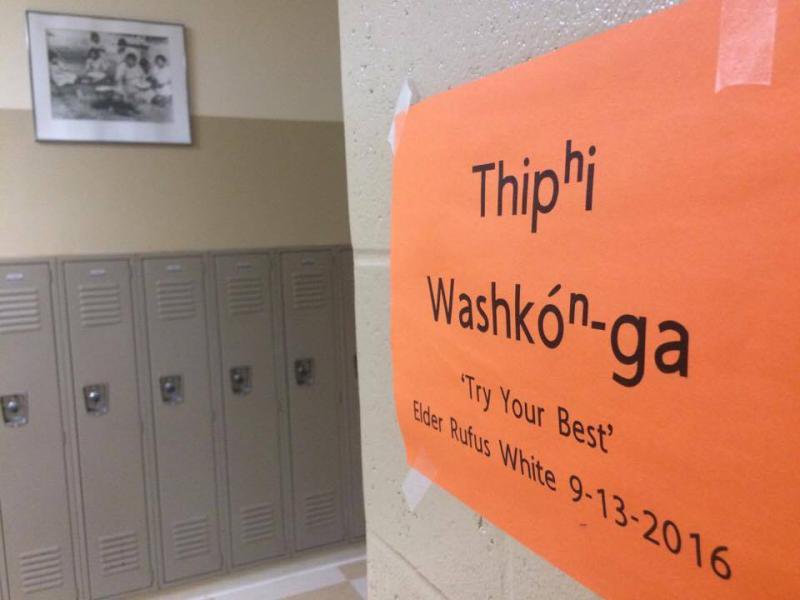Nebraska tribe looks to language in preserving culture
Ben Bohall | Nebraska Public Media | June 13, 2017

The Omaha Tribe in Macy, Nebraska are trying to encourage members of their community to learn and practice their traditional language, as seen here in this sign posted in the Omaha Nation Public School. (Photo by Ben Bohall, NET News)
Even though he’s 79 year-old, Rufus White still remembers his first day of kindergarten like it was yesterday. Mainly because he and several other students were kicked out of class.
“It was hard for us to understand the teacher. She was asking us what our names were and we didn’t understand her,” White recalled. “We were speaking our language. We couldn’t understand her and she couldn’t understand us, so they sent us home.”
White is a member of Nebraska’s Omaha tribe. His teacher sent him home that day with a note to his parents. It said “I can’t communicate with your son.” It was then his parent’s told him a lesson that would follow him for the rest of his life as a Native American man:
“Things are changing. People have got to change their ways. We’re not going to be the same anymore. We’re going to have to live in a white world.”
White’s story was pretty common during the time. Following an 1854 treaty ceding much of the Omaha Tribe’s Nebraska lands, reservation boarding schools were established to promote white culture to the tribe’s children. Most schools up until the 1960’s forced students to speak only English. That left few members of the tribe completely fluent in the language.
For the past 18 years, Vida Stabler, and a small staff including White, have been teaching the Omaha language to students at the Omaha Nation Public School in an attempt to keep it alive among the tribe’s youth.
“With the passing of elders, we’re facing difficulty of language loss and fluent speakers,” Stabler said.
The curriculum they’ve developed is largely influenced by the tribe’s traditions.
“Our department really took our community, brought them into the school system, we sat and said, ‘Ok, let’s decide what we want to teach our children,’” Stabler said.
The courses are taught in a large room resembling an earth lodge. It’s furnished with pieces representative of Omaha culture, including drums and head dresses. The rest of the Omaha Nation Public School’s halls are adorned with intricate murals combining the English and Omaha languages. It’s all part of a larger attempt to keep students interested in their ancestry.
“Kids are kids. Here on our reservation, they’re just as impacted by mass media as anybody. But what we do have here is a strong culture in our community. They do come with the foundation of who they are as Omaha people,” Stabler said.
The efforts haven’t involved only traditional students. Down the road at the Nebraska Indian Community College, tribal elder Winona Caramony begins her class with a tribal ritual:
“In my teaching, I always try to start my classes with a prayer because our Omaha people believed in prayers,” Caramony explained.
Caramony then guides a small group of students ranging in age from 23 to 88 through an exercise describing the names and colors of different animals in the Omaha language.
The efforts here and at the Omaha Nation Public School by the tribe is one of many by Native American tribes hoping to keep their traditions and languages alive. But does it work?
George Aaron Broadwell is an anthropology professor at the University of Florida. He specializes in Native American Languages and their survival rates.
“I think it might depend on how you define success here. Young people can often learn to exchange greetings in their language, or say prayers, or sing songs. Maybe learn the names of things that are cultural important for the tribe,” Broadwell said.
Broadwell said fluency, typically involves being completely immersed in the language. He pointed to the Seminole reservation in south Florida where immersion schools in the tribe’s native language, Creek, are being run for preschoolers. Classes run all morning until lunch, where only Creek is spoken. Students go from being non-speakers to almost fluent.
“That’s pretty encouraging because prior to this there were no speakers of Creek on this reservation that were younger than 50 or 60,” Broadwell said.
Over the past decade, the Omaha Nation Public Schools and University of Nebraska-Lincoln have partnered to complete the first Omaha language textbook, expected to be released next year. The tribe has also partnered with the Language Conservancy Project with the hope of developing language immersion programs. With all the progress being made, Stabler says she’s seen the results of the work with her students. She just hopes they’ll remember where they came from as they move forward in life.
“We want them to see the value of who they are as Omaha people and how that will actually give you a solid foundation so you can achieve whatever in life you want to achieve… Hold onto that when the times get tough because that’s what going to get you through: Knowing who you are,” Stabler said.

